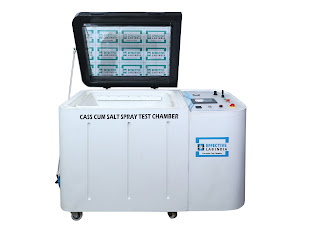Assess Surface Coatings’ Durability in a Corrosive Saline Environment
Are you bored and weary of surface treatments that look durable but can't hold up in harsh, salty environments? If so, it's time to get comfortable and use the Effective Lab India salt spray test chamber to evaluate the items' durability. One of the best pieces of laboratory equipment for assessing the resistance to corrosion of materials used in the production of fastening products is the Jupiter Series Computerised salt spray chamber.
A mix of laboratory tests, field assessments, and consideration of the particular circumstances the coatings would be exposed to are used to evaluate the endurance of surface coatings in a corrosive, salty environment.
The Value of Evaluating the Durability of Surface Coatings
To guarantee the long-term performance of surface coatings, it is imperative to verify their durability in corrosive saline conditions. One of the most popular techniques for assessing a coating's corrosion resistance is salt spray testing.
In this kind of testing, a salt spray—typically sodium chloride—is applied to the coated surface, and the quantity of corrosion that results is then measured. The outcome of the salt spray test chamber can provide important details regarding the longevity and practical performance of a coating.
The following are some actions and strategies to keep in mind concerning:
Knowing the Environment: Determine the particular corrosive agents in the salty environment, taking into account factors like temperature, humidity, salt content, and length of exposure. Any other stresses that can affect the effectiveness of the coating, such as UV radiation, abrasion, or chemical exposure, should be taken into account.
Selecting the Right Material: Pick coatings recognised for their ability to withstand corrosion in salty conditions. Materials that are frequently appropriate include epoxy, polyurethane, and fluoropolymers.
Laboratory Examinations: Perform corrosion resistance-related standardised tests, such as those from the ISO (International Organisation for Standardisation) or ASTM (American Society for Testing and Materials). Tests for accelerated corrosion, including salt spray testing (ASTM B117), can quickly replicate years of exposure.
Testing for Corrosion Under Insulation (CUI): Simulate circumstances in which insulation might force moisture up against the substrate, causing corrosion. Analyse the coating's resistance to this particular kind of corrosion.
Testing for Field Exposure: Place coated samples in their real usage environment and check them regularly for corrosion and coating deterioration. To replicate real-world circumstances, assess the performance over a lengthy period.
Keeping an eye on corrosion rates: To determine the corrosion rate under various coating systems, use corrosion rate measuring techniques such as corrosion coupons or electrochemical methods.
Visual Examination: Check the coated surfaces often for any indications of coating failure, such as blistering, cracking, peeling, or discolouration.
Features of Effective Lab India Salt Spray Test Chamber:
This testing instrument is a crucial apparatus for any testing programme because it offers a reliable and accurate simulation of actual weathering conditions. Manufacturers may be guaranteed that their products will survive exposure to salt spray and other corrosive environments by using the salt spray chamber.
Here are some important features of the salt spray test chamber:
- Testing different grades of metal is simple.
- There are electronic controls available for a productive manner of operation.
- Testing yields very accurate findings.
- Strong rigging material is used in its structure to ensure successful testing.
- The machine runs smoothly because data handling is simple.
- Constructed to conform to industrial requirements.
- Timer functions that yield precise results.
- It is possible to select certain temperatures for testing.
- Clear canopy to view the inside workings.
Technical Specifications of Salt Spray Testing Chamber:
- Temperature Range of the Chamber: Ambient to 40°C
- Test for Power: 220V, Single Phase, 50Hz, 15 A air pressure between 0.7 and 1.2 kg/cm²
- Examine Temperature Range of the Chamber: 35°C ± 2°C
- Temperature List for Chambers: Count<0.1°C
- pH value of salt solution: 6.5 to 7.2; Temperature Control: Integrated PID Temperature Controller
- Least Count for Air Saturator Temperature<0.1ºC
- Repeatability of Air Saturator Temperature<± 2ºC
Keep in mind that things like surface preparation, application technique, and upkeep might influence a coating's efficacy. To guarantee the long-term endurance of coatings in corrosive salt environments, routine maintenance and inspections are essential.
Manufacturers can simply conduct salt spray testing on the materials and provide clients with high-quality goods thanks to these advanced features and technical standards. You may contact us by email at info@effectivelabindia.com or by phone at +91 9555515525 if you would like more information regarding the usage of this quality testing equipment. You can speak with our team of technical specialists about any demands or questions you may have.
%20(1).jpg)



Comments
Post a Comment